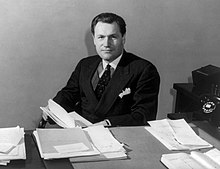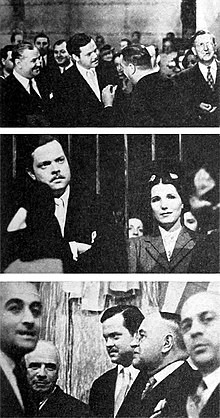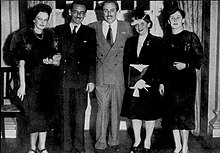
Saludos Amigos is a 1942 American live-action/animated propaganda anthology film produced by Walt Disney and released by RKO Radio Pictures. Set in Latin America, it is made up of four different segments; Donald Duck stars in two of them and Goofy stars in one. It also features the first appearance of José Carioca, the Brazilian cigar-smoking parrot. Saludos Amigos premiered in Rio de Janeiro on August 24, 1942. It was released in the United States on February 6, 1943.

The Good Neighbor policy was the foreign policy of the administration of United States President Franklin D. Roosevelt towards Latin America. Although the policy was implemented by the Roosevelt administration, President Woodrow Wilson had previously used the term, but subsequently went on to justify U.S. involvement in the Mexican Revolution and occupation of Haiti. Senator Henry Clay had coined the term Good Neighbor in the previous century. President Herbert Hoover turned against interventionism and developed policies that Roosevelt perfected.
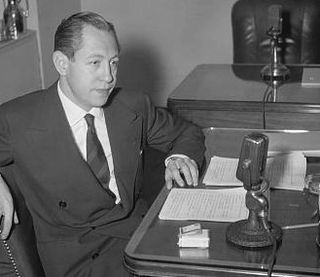
William Samuel Paley was an American businessman, primarily involved in the media, and best known as the chief executive who built the Columbia Broadcasting System (CBS) from a small radio network into one of the foremost radio and television network operations in the United States. He was awarded the Carlos Manuel de Cespedes National Order of Merit by the Cuban government in recognition of his efforts to foster greater understanding between the peoples of Cuba and the United States of America.

Pan-Americanism is a movement that seeks to create, encourage, and organize relationships, an association, and cooperation among the states of the Americas, through diplomatic, political, economic, and social means.
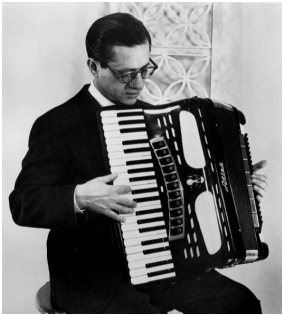
John Serry Sr. was an American concert accordionist, arranger, composer, organist, and educator. He performed on the CBS Radio and Television networks and contributed to Voice of America's cultural diplomacy initiatives during the Golden Age of Radio. He also concertized on the accordion as a member of several orchestras and jazz ensembles for nearly forty years between the 1930s and 1960s.

It's All True is an unfinished Orson Welles feature film comprising three stories about Latin America. "My Friend Bonito" was supervised by Welles and directed by Norman Foster in Mexico in 1941. "Carnaval" and "Jangadeiros" were directed by Welles in Brazil in 1942. It was to have been Welles's third film for RKO Radio Pictures, after Citizen Kane (1941) and The Magnificent Ambersons (1942). The project was a co-production of RKO and the Office of the Coordinator of Inter-American Affairs that was later terminated by RKO.

World War II was the first conflict to take place in the age of electronically distributed music.
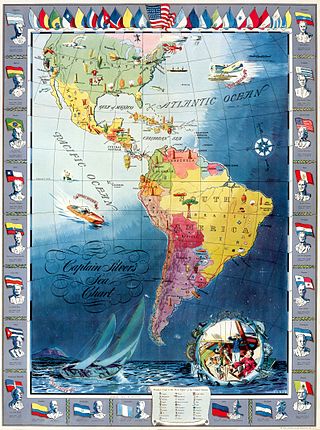
The Sea Hound is an American radio adventure series that ran from June 29, 1942, to August 7, 1951. It began on the Blue Network June 29, 1942 – September 22, 1944, as a 15-minute serial for young audiences, featuring Ken Daigneau as Captain Silver of the ship The Sea Hound. Other members of the cast were Barry Thompson as Captain Silver, Bob Hastings as Jerry, and Alan Devitt as Kai. Doug Browning was the announcer.
Robert Talbott Miller III was an American citizen who worked in the United States Office of the Coordinator of Inter-American Affairs during World War II. He was alleged to be part of the Soviet espionage group known as the "Golos ring" in the 1940s.

Viva América was an American musical radio program which was broadcast live over the CBS radio network and to North and South America over the "La Cadena de las Américas" during the 1940s (1942–1949) in support of Pan-Americanism during World War II. It was also broadcast for the benefit of members of the armed forces in Europe during World War II over the Armed Forces Network. All broadcasts of this program were supervised under the strict government supervision of the United States Department of State and the Office of the Coordinator of Inter-American Affairs (OCIAA) as part of the United States Cultural Exchange Programs cultural diplomacy initiative authorized by President Franklin D. Roosevelt during World War II through the Office for Coordination of Commercial and Cultural Relations (OCCCRBAR) and the Office of the Coordinator of Inter-American Affairs directed by Nelson Rockefeller.
Edmund Albert Chester Sr. was an American television executive. He served as a vice president and executive at the CBS radio and television networks during the 1940s. As Director of Latin American Relations he collaborated with the Department of State to develop CBS's "La Cadena de Las Americas" radio network in support of Pan-Americanism during World War II. He also served as a highly respected journalist and Bureau Chief for Latin America at Associated Press and Vice President at La Prensa Asociada in the 1930s. He was awarded the Carlos Manuel de Cespedes National Order of Merit by the government of Cuba in recognition of his efforts to foster greater understanding between the peoples of Cuba and the United States of America.
Between 1941 and 1945, during World War II, Walt Disney was involved in the production of propaganda films for the U.S. government. The widespread familiarity of Disney's productions benefited the U.S. government in producing pro-American war propaganda in an effort to increase support for the war.
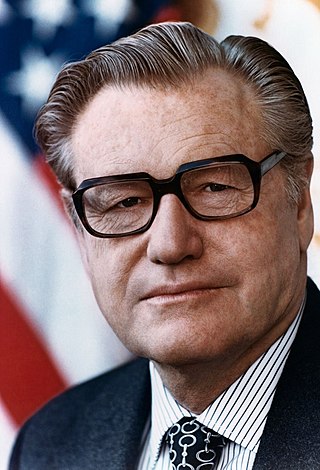
Nelson Aldrich Rockefeller, sometimes referred to by his nickname Rocky, was an American businessman and politician who served as the 41st vice president of the United States from 1974 to 1977 under President Gerald Ford. A member of the Republican Party and the wealthy Rockefeller family, he previously served as the 49th governor of New York from 1959 to 1973. Rockefeller also served as assistant secretary of State for American Republic Affairs for Presidents Franklin D. Roosevelt and Harry S. Truman (1944–1945) as well as under secretary of Health, Education and Welfare (HEW) under Dwight D. Eisenhower from 1953 to 1954. A son of John D. Rockefeller Jr. and Abby Aldrich Rockefeller as well as a grandson of Standard Oil co-founder John D. Rockefeller, he was a noted art collector and served as administrator of Rockefeller Center in Manhattan, New York City.
World War II changed the possibilities for animation. Prior to the war, animation was mostly seen as a form of family entertainment. The attack on Pearl Harbor was a turning point in its utility. On December 8, 1941, the United States Army began working with Walt Disney at his studio, stationing Military personnel there for the duration of the war. The Army and Disney set about making various types of films for several different audiences. Most films meant for the public included some type of propaganda, while films for the troops included training and education about a given topic.
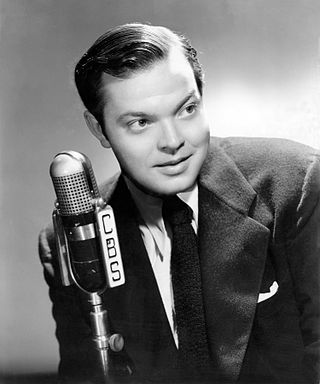
The Orson Welles Show (1941–42), also known as The Orson Welles Theater, Orson Welles and his Mercury Theater and the Lady Esther Show, was a live CBS Radio series produced, directed and hosted by Orson Welles. Broadcast Mondays at 10 p.m. ET, it made its debut September 15, 1941. Its last broadcast was February 2, 1942.

Hello Americans (1942–43) is a CBS Radio series produced, directed and hosted by Orson Welles. Created to promote inter-American understanding and friendship during World War II, the series aired Sundays at 8 p.m. ET beginning November 15, 1942. Its last broadcast was January 31, 1943. Sponsored by the Office of the Coordinator of Inter-American Affairs, the drama series featured many of the actors from Welles's Mercury Theatre repertory ensemble.

The Grain That Built a Hemisphere is a 1943 short animated propaganda film about corn produced by Walt Disney for the Office of the Coordinator of Inter-American Affairs. It was nominated for an Academy Award for Best Documentary in 1943.

During World War II, a number of significant economic, political, and military changes took place in Latin America. The war caused considerable panic in the region over economics as large portions of economy of the region depended on the European investment capital, which was shut down. Latin America tried to stay neutral at first but the warring countries were endangering their neutrality. In order to better protect the Panama Canal, combat Axis influence, and optimize the production of goods for the war effort, the United States through Lend-Lease and similar programs greatly expanded its interests in Latin America, resulting in large-scale modernization and a major economic boost for the countries that participated.
Eva Garza was a Mexican-American singer and film actress who acquired international recognition in the 1940s and 1950s during the Golden Age of Mexican cinema. She collaborated on live radio shows and films with some of the leading performers of her time, including Mexico's Agustín Lara. She was nicknamed "Sweetheart of the Americas".

The third presidential term of Franklin D. Roosevelt began on January 20, 1941, when he was once again inaugurated as the 32nd president of the United States, and the fourth term of his presidency ended with his death on April 12, 1945. Roosevelt won a third term by defeating Republican nominee Wendell Willkie in the 1940 United States presidential election. He remains the only president to serve for more than two terms. Unlike his first two terms, Roosevelt's third and fourth terms were dominated by foreign policy concerns, as the United States became involved in World War II in December 1941.

